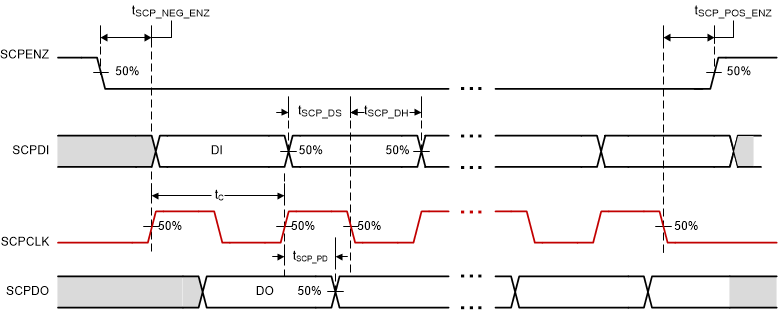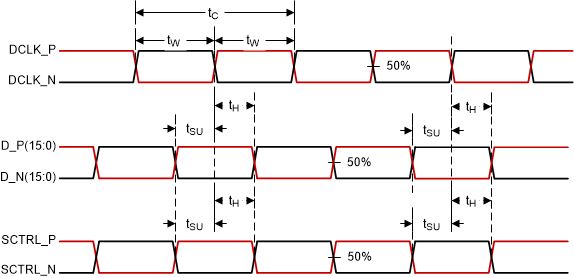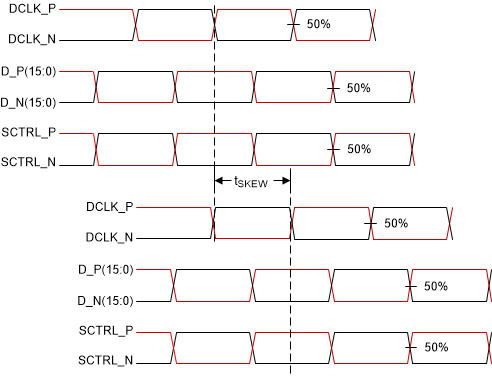ZHCSKV8A November 2020 – June 2022 DLP670S
PRODUCTION DATA
- 1 特性
- 2 应用
- 3 说明
- 4 Revision History
- 5 Pin Configuration and Functions
-
6 Specifications
- 6.1 Absolute Maximum Ratings
- 6.2 Storage Conditions
- 6.3 ESD Ratings
- 6.4 Recommended Operating Conditions
- 6.5 Thermal Information
- 6.6 Electrical Characteristics
- 6.7 Capacitance at Recommended Operating Conditions
- 6.8 Timing Requirements
- 6.9 Typical Characteristics
- 6.10 System Mounting Interface Loads
- 6.11 Micromirror Array Physical Characteristics
- 6.12 Micromirror Array Optical Characteristics
- 6.13 Window Characteristics
- 6.14 Chipset Component Usage Specification
- 7 Detailed Description
- 8 Application and Implementation
- 9 Power Supply Recommendations
- 10Layout
- 11Device and Documentation Support
- 12Mechanical, Packaging, and Orderable Information
6.8 Timing Requirements
| MIN | NOM | MAX | UNIT | |||
|---|---|---|---|---|---|---|
| SCP(1) | ||||||
| tr | Rise time | 20% to 80% reference points | 30 | ns | ||
| tf | Fall time | 80% to 20% reference points | 30 | ns | ||
| LVDS(2) | ||||||
| tr | Rise slew rate | 20% to 80% reference points | 0.7 | 1 | V/ns | |
| tf | Fall slew rate | 80% to 20% reference points | 0.7 | 1 | V/ns | |
| tC | Clock Cycle | DCLK_A, LVDS pair | 2.5 | ns | ||
| tC | Clock Cycle | DCLK_B, LVDS pair | 2.5 | ns | ||
| tC | Clock Cycle | DCLK_C, LVDS pair | 2.5 | ns | ||
| tC | Clock Cycle | DCLK_D, LVDS pair | 2.5 | ns | ||
| tW | Pulse Width | DCLK_A LVDS pair | 1.19 | 1.25 | ns | |
| tW | Pulse Width | DCLK_B LVDS pair | 1.19 | 1.25 | ns | |
| tW | Pulse Width | DCLK_C LVDS pair | 1.19 | 1.25 | ns | |
| tW | Pulse Width | DCLK_D LVDS pair | 1.19 | 1.25 | ns | |
| tSu | Setup Time | D_A(15:0) before DCLK_A, LVDS pair | 0.325 | ns | ||
| tSu | Setup Time | D_B(15:0) before DCLK_B, LVDS pair | 0.325 | ns | ||
| tSu | Setup Time | D_C(15:0) before DCLK_C, LVDS pair | 0.325 | ns | ||
| tSu | Setup Time | D_D(15:0) before DCLK_D, LVDS pair | 0.325 | ns | ||
| tSu | Setup Time | SCTRL_A before DCLK_A, LVDS pair | 0.325 | ns | ||
| tSu | Setup Time | SCTRL_B before DCLK_B, LVDS pair | 0.325 | ns | ||
| tSu | Setup Time | SCTRL_C before DCLK_C, LVDS pair | 0.325 | ns | ||
| tSu | Setup Time | SCTRL_D before DCLK_D, LVDS pair | 0.325 | ns | ||
| th | Hold Time | D_A(15:0) after DCLK_A, LVDS pair | 0.145 | ns | ||
| th | Hold Time | D_B(15:0) after DCLK_B, LVDS pair | 0.145 | ns | ||
| th | Hold Time | D_C(15:0) after DCLK_C, LVDS pair | 0.145 | ns | ||
| th | Hold Time | D_D(15:0) after DCLK_D, LVDS pair | 0.145 | ns | ||
| th | Hold Time | SCTRL_A after DCLK_A, LVDS pair | 0.145 | ns | ||
| th | Hold Time | SCTRL_B after DCLK_B, LVDS pair | 0.145 | ns | ||
| th | Hold Time | SCTRL_C after DCLK_C, LVDS pair | 0.145 | ns | ||
| th | Hold Time | SCTRL_D after DCLK_D, LVDS pair | 0.145 | ns | ||
| LVDS(2) | ||||||
| tSKEW | Skew Time | Channel B relative to Channel A(3)(4), LVDS pair | –1.25 | +1.25 | ns | |
| tSKEW | Skew Time | Channel D relative to Channel C(5)(6), LVDS pair | –1.25 | +1.25 | ns | |
(1) See Figure 6-3 for Rise Time and Fall Time for SCP.
(2) See Figure 6-5 for Timing Requirements for LVDS.
(3) Channel A (Bus A) includes the following LVDS pairs: DCLK_AN and DCLK_AP, SCTRL_AN and SCTRL_AP, D_AN(15:0) and D_AP(15:0).
(4) Channel B (Bus B) includes the following LVDS pairs: DCLK_BN and DCLK_BP, SCTRL_BN and SCTRL_BP, D_BN(15:0) and D_BP(15:0).
(5) Channel C (Bus C) includes the following LVDS pairs: DCLK_CN and DCLK_CP, SCTRL_CN and SCTRL_CP, D_CN(15:0) and D_CP(15:0).
(6) Channel D (Bus D) includes the following LVDS pairs: DCLK_DN and DCLK_DP, SCTRL_DN and SCTRL_DP, D_DN(15:0) and D_DP(15:0).
 Figure 6-2 SCP Timing Requirements
Figure 6-2 SCP Timing RequirementsA. See
Section 6.4
for fSCPCLK, tSCP_DS, tSCP_DH and
tSCP_PD specifications.
B. SCPCLK falling–edge capture for SCPDI.
C. SCPCLK rising–edge launch for SCPDO.
D. See Equation 1.
Equation 1. 

Figure 6-3 SCP
Requirements for Rise and Fall
See Section 6.8 for tr and tf specifications and conditions.
 Figure 6-4 Test Load Circuit for Output Propagation Measurement
Figure 6-4 Test Load Circuit for Output Propagation MeasurementFor output timing analysis, the tester pin electronics and its transmission line effects must be taken into account. System designers must use IBIS or other simulation tools to correlate the timing reference load to a system environment.
Equation 2. 

Equation 3. 

See Section 6.4 for VCM, VID, and VLVDS specifications and conditions.
 Figure 6-6 Timing Requirements
Figure 6-6 Timing Requirements Figure 6-7 LVDS Interface Channel Skew Definition
Figure 6-7 LVDS Interface Channel Skew DefinitionSee Section 6.8 for timing requirements and LVDS pairs per channel (bus) defining D_P(15:0) and D_N(15:0).
